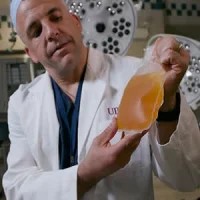Research published in the British Journal of Surgery has revealed that a mere two per cent of patients with life-threatening bleeding after serious injury receive optimal blood transfusion therapy in England and Wales. The study was led by Queen Mary University of London (QMUL) and the National Health Service (NHS) Blood and Transplant.
It is estimated that close to 5,000 trauma patients sustain major haemorrhage in England and Wales each year and that one-third of those die. Delays in blood transfusion practices and the challenging logistics of supplying the right quantity of red blood cells, plasma and other clotting products during the first minutes of emergency treatment may contribute to this high death rate.
Professor Karim Brohi, Chair of Trauma Sciences at Queen Mary University of London, and a Trauma Surgeon at the Royal London Hospital Major Trauma Centre, said: "There is a clear opportunity for clinicians to improve the delivery of blood and clotting products during resuscitation for major haemorrhage."
This study examined the cases of 442 patients at 22 hospitals in England and Wales, who had experienced major trauma haemorrhage. Nearly two-thirds of all deaths occurred in the first 24 hours. An unexpectedly high number of deaths (7.9 per cent) occurred once the patient left hospital, the reasons for which are unclear. Two per cent of all patients with massive haemorrhage received what might be considered the optimal transfusion of a high dose of clotting products in conjunction with red blood cells during the first hour of arrival within the Emergency Department.
Average time to transfusion of red blood cells was longer than expected, at 41 minutes. Administration of specific blood components to aid with blood clotting such as plasma, platelets and cryoprecipitate was significantly delayed, occurring on average 2-3 hours after admission.
Patients over 65 years of age were twice as likely to suffer massive haemorrhage as a result of an injury compared to younger groups. The causes for this were unclear and the researchers say further investigation is needed to examine the role of associated medical problems and prescribed medication and whether transfusion procedures may need to be adapted for older patients.
See Also: Massive Blood Transfusion - Lessons from the Military
Professor Brohi added: "The rapid delivery of the right mix of blood components in an emergency environment is extremely challenging. Some transfusion components have to be thawed and at present aren't always available for the patient quickly enough. More research is also needed into techniques and devices to control bleeding earlier - even at the scene of injury."
Dr Simon Stanworth, at NHSBT/Oxford University Hospitals NHS Trust, said: “Whilst the reasons for delays are varied between hospitals, NHSBT is looking at ways to improve the availability of blood components, for example, using promoting and assessing different types of plasma, such as extended pre-thawed or liquid plasma, which would be more readily available for timely use. This area of the optimal products remains a high-priority for NHSBT and indeed all Blood Transfusion Services. "
The authors note the study limitations - data was not complete for all patients, including stimings of transfusions. The study was also undertaken at an early stage in national trauma network reorganisation.
Image credit: freeimages.com
It is estimated that close to 5,000 trauma patients sustain major haemorrhage in England and Wales each year and that one-third of those die. Delays in blood transfusion practices and the challenging logistics of supplying the right quantity of red blood cells, plasma and other clotting products during the first minutes of emergency treatment may contribute to this high death rate.
Professor Karim Brohi, Chair of Trauma Sciences at Queen Mary University of London, and a Trauma Surgeon at the Royal London Hospital Major Trauma Centre, said: "There is a clear opportunity for clinicians to improve the delivery of blood and clotting products during resuscitation for major haemorrhage."
This study examined the cases of 442 patients at 22 hospitals in England and Wales, who had experienced major trauma haemorrhage. Nearly two-thirds of all deaths occurred in the first 24 hours. An unexpectedly high number of deaths (7.9 per cent) occurred once the patient left hospital, the reasons for which are unclear. Two per cent of all patients with massive haemorrhage received what might be considered the optimal transfusion of a high dose of clotting products in conjunction with red blood cells during the first hour of arrival within the Emergency Department.
Average time to transfusion of red blood cells was longer than expected, at 41 minutes. Administration of specific blood components to aid with blood clotting such as plasma, platelets and cryoprecipitate was significantly delayed, occurring on average 2-3 hours after admission.
Patients over 65 years of age were twice as likely to suffer massive haemorrhage as a result of an injury compared to younger groups. The causes for this were unclear and the researchers say further investigation is needed to examine the role of associated medical problems and prescribed medication and whether transfusion procedures may need to be adapted for older patients.
See Also: Massive Blood Transfusion - Lessons from the Military
Professor Brohi added: "The rapid delivery of the right mix of blood components in an emergency environment is extremely challenging. Some transfusion components have to be thawed and at present aren't always available for the patient quickly enough. More research is also needed into techniques and devices to control bleeding earlier - even at the scene of injury."
Dr Simon Stanworth, at NHSBT/Oxford University Hospitals NHS Trust, said: “Whilst the reasons for delays are varied between hospitals, NHSBT is looking at ways to improve the availability of blood components, for example, using promoting and assessing different types of plasma, such as extended pre-thawed or liquid plasma, which would be more readily available for timely use. This area of the optimal products remains a high-priority for NHSBT and indeed all Blood Transfusion Services. "
The authors note the study limitations - data was not complete for all patients, including stimings of transfusions. The study was also undertaken at an early stage in national trauma network reorganisation.
Image credit: freeimages.com
References:
Stanworth SJ, Davenport R, Curry N et al. (2016) Mortality from trauma haemorrhage and opportunities for improvement in transfusion practice. British Journal of Surgery. DOI: 10.1002/bjs.10052. Published online 3 February.
Latest Articles
Trauma, Transfusion
Study in England and Wales found that only 2 percent of trauma patients received optimal blood transfusion










